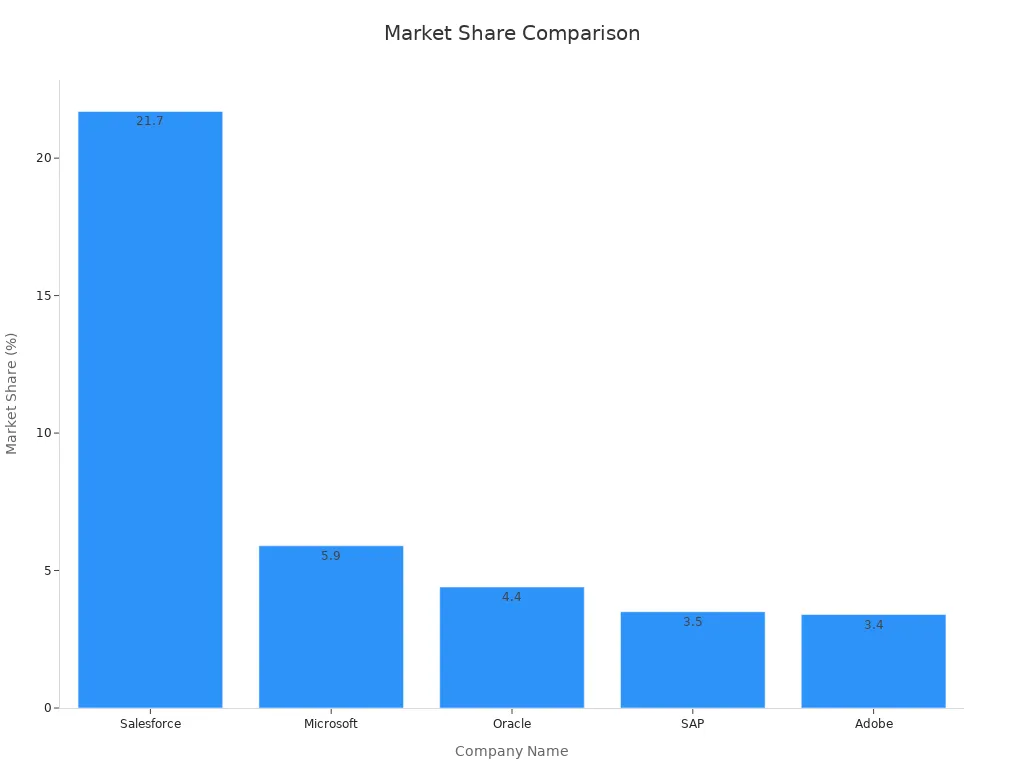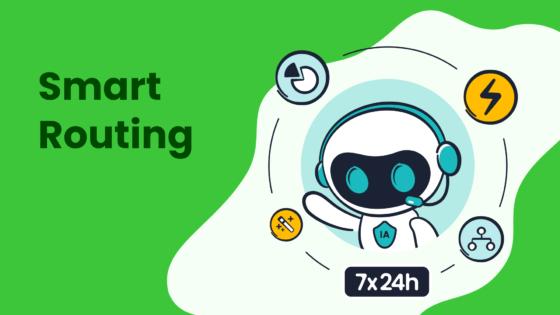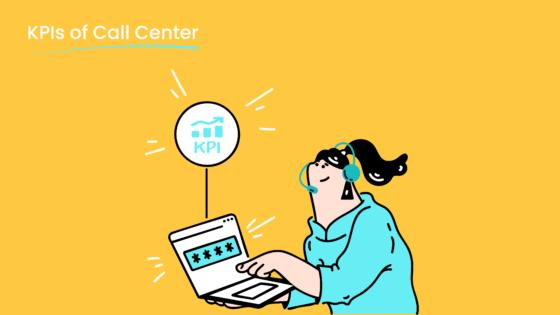Enhance Call Center Performance with These CRM Tools

Running a call center isn’t easy, right? You’re constantly juggling customer expectations, agent performance, and operational efficiency. That’s where CRM tools step in to save the day. They transform how your team manages calls, tracks data, and delivers top-notch service. Did you know 86% of customers leave a brand after just two bad experiences? That’s why having the right contact center crm can make all the difference. Tools like Sobot not only streamline workflows but also help reduce costly agent turnover, which can exceed $2,500 per employee. It’s time to rethink how you handle customer interactions.
What Is CRM Software and Its Role in Call Centers?
Definition of CRM Software
Customer Relationship Management (CRM) software is a tool that helps businesses manage and improve their interactions with customers. It integrates communication channels, business processes, and departments to create a seamless experience. Think of it as the backbone of your call center, organizing customer data and making it accessible to your team.
Here’s a quick breakdown of CRM software:
| Aspect | Definition |
|---|---|
| General Definition | Customer Relationship Management integrates all business processes, communication channels, and company departments that have direct contact with customers. |
| Forms of CRM | Analytical CRM, Collaborative CRM, Operative CRM, and Communicative CRM. |
| Purpose | Designed to help organizations provide a unique and seamless customer experience while building better relationships. |
By using CRM software, you can track sales, manage customer relationships, and even collaborate across teams more effectively.
Key Functions of CRM in Call Centers
CRM for call centers is more than just a database. It’s a powerhouse of features that streamline operations and improve customer satisfaction. Here are some key functions:
| Key Function | Description |
|---|---|
| Call Handling | Integrates call routing, IVR, and real-time monitoring for efficient customer interaction management. |
| Performance Analytics | Provides insights into KPIs like average call time and resolution rates for monitoring agent performance. |
| Customer Information Access | Offers agents instant access to customer data, reducing search time and enhancing service efficiency. |
| Personalized Interactions | Centralizes customer history to enable tailored interactions, improving customer satisfaction. |
For example, intelligent call routing ensures that customers are connected to the right agent quickly, reducing wait times and improving the overall experience.
Why CRM Is Essential for Call Center Success
Why does your call center need CRM software? The answer lies in its ability to transform both customer and agent experiences.
- Customer Experience (CX): Up to 32% of customers stop doing business after a bad experience. CRM tools help you avoid this by improving interactions.
- Agent Satisfaction: Happy agents lead to happy customers. CRM software boosts agent satisfaction, which can increase customer satisfaction scores by 62%.
- Efficiency Metrics: CRM tools optimize critical metrics like call routing, average handling time (AHT), and first call resolution (FCR).
Take Southwest Airlines as an example. By implementing CRM software, they reduced call volumes and improved productivity. This shows how CRM tools can directly impact your call center’s success.
Top CRM Tools for Call Centers in 2025

Choosing the right CRM tool can make or break your call center’s performance. With so many options available, it’s essential to focus on solutions that align with your needs. Let’s dive into three of the best CRMs for call centers in 2025.
Zoho CRM: A Customizable Solution for Call Centers
Zoho CRM stands out for its flexibility and robust features tailored to call centers. It’s perfect if you’re looking for a solution that adapts to your unique workflows. With Zoho, you can automate repetitive tasks, integrate telephony systems, and track customer interactions effortlessly.
Here’s why Zoho CRM is a favorite among call centers:
- Automatic Call Logging: Every call is logged automatically, saving agents time and ensuring no interaction slips through the cracks.
- Workflow Automation: Streamline processes like follow-ups and ticket escalations with customizable workflows.
- Integration with Telephony: Connect your existing call center software for seamless communication.
Zoho also excels in performance tracking. You can monitor metrics like call resolution rates, average response times, and customer satisfaction scores. This data helps you allocate resources efficiently and identify training opportunities for your team.
| Performance Metric | Description |
|---|---|
| Real-time average response time | Tracks how quickly calls are answered, boosting customer satisfaction. |
| Call volumes | Helps you understand the number of calls received, aiding in resource planning. |
| Customer satisfaction scores | Measures how happy customers are with your service, guiding improvements. |
| Call resolution rates | Shows how effectively agents resolve issues, essential for performance monitoring. |
| Duration rates | Tracks call lengths, offering insights into efficiency and training needs. |
If you’re after a CRM that grows with your business, Zoho CRM is a top contender.
HubSpot CRM: Real-Time Communication Tracking
HubSpot CRM is a game-changer when it comes to real-time communication tracking. It’s designed to centralize all your customer interactions, making it easier for agents to deliver personalized service.
What makes HubSpot CRM shine?
- Email Tracking: Know when customers open your emails, click links, or reply. This feature keeps you in the loop and helps you follow up effectively.
- Activity Feed: Get a chronological view of every interaction, ensuring no detail is missed.
- Conversations Inbox: Manage messages from multiple channels in one place, enabling timely responses.
These features make HubSpot one of the best call center CRM tools for improving communication efficiency. Imagine having all your customer data and interactions in one unified workspace. It’s a productivity booster for your agents and a satisfaction driver for your customers.
HubSpot also offers native telephony integration and advanced automation, making it a strong choice for call centers aiming to enhance their operations.
Salesforce Service Cloud: Market Leader in CRM
Salesforce Service Cloud has long been a leader in the CRM space, and for good reason. It’s packed with features that cater to the complex needs of modern call centers. From intelligent call routing to predictive AI, Salesforce has it all.
Here’s what sets Salesforce apart:
- Call Routing: Ensure customers are connected to the right agent based on their needs, reducing wait times and improving first-call resolution.
- Predictive AI: Anticipate customer needs and provide agents with actionable insights during calls.
- Enterprise Integration: Seamlessly connect with tools like ERP systems and marketing platforms for a unified experience.
Salesforce’s dominance in the CRM market is undeniable. It holds a 21.7% market share, far ahead of competitors like Microsoft and Oracle.

This widespread adoption isn’t just about features. Salesforce’s high customer retention rate, ranging from 7-10%, speaks volumes about its reliability and effectiveness. Switching to other software often involves significant costs and risks, making Salesforce a trusted choice for businesses worldwide.
If you’re looking for the best call center CRM to handle complex operations, Salesforce Service Cloud is a no-brainer.
Freshsales: AI-Powered Call Center CRM
Freshsales is a standout choice for call centers looking to harness the power of AI. It’s designed to simplify your operations while boosting efficiency. Imagine having a tool that not only tracks calls but also helps you prioritize leads based on their likelihood to convert. That’s exactly what Freshsales offers.
Here’s why Freshsales is a game-changer for call centers:
- AI-Driven Insights: Freshsales uses AI to clean up data inaccuracies and organize it into actionable formats. This improves your team’s outreach and sales efficiency.
- Lead Prioritization: The built-in AI ranks leads by their conversion potential, so your agents can focus on high-value opportunities.
- Seamless Integration: It connects with phone systems, allowing you to manage calls and leads from one interface.
The results speak for themselves. Businesses using AI in sales have seen revenue increases of 5-15% and cost reductions of 10-20%. By automating repetitive tasks and allocating resources smarter, Freshsales helps you achieve more with less effort.
Freshsales also excels in call routing. Its intelligent call routing ensures customers are directed to the right agent, reducing wait times and improving first-call resolution rates. This feature alone can transform your customer experience and boost satisfaction.
If you’re searching for call center CRM software that combines AI with user-friendly features, Freshsales deserves your attention.

Sobot Voice/Call Center: Intelligent and Scalable CRM Solution
When it comes to intelligent and scalable solutions, Sobot Voice/Call Center stands out as a top-tier option. It’s not just a call center software; it’s a comprehensive platform designed to enhance every aspect of your operations. Whether you’re managing inbound or outbound calls, Sobot has you covered.
Here’s what makes Sobot Voice/Call Center exceptional:
- Smart Call Routing: Sobot’s intelligent call routing ensures every customer reaches the right agent or team. This reduces wait times and improves resolution rates.
- Unified Workspace: Your agents get a single, streamlined interface to manage calls and customer data, boosting productivity.
- AI-Powered Voicebot: With advanced AI, Sobot’s voicebot handles routine queries, freeing up your agents for more complex tasks.
- Global Reach: Need to connect with customers worldwide? Sobot provides global number availability and supports multiple time zones.
Sobot’s platform isn’t just about features; it’s about results. For example, Samsung used Sobot’s solution to unify its communication channels and improve agent efficiency by 30%. The system’s 99.99% uptime ensures your operations run smoothly, no matter the scale.
With Sobot, you also get robust monitoring and analytics tools. These provide real-time insights into call data, helping you make informed decisions. Plus, the platform integrates seamlessly with your existing CRM software, making it a perfect fit for any contact center CRM strategy.
If you’re ready to take your call center to the next level, Sobot Voice/Call Center is the solution you’ve been waiting for.
Benefits of Using CRM Tools in Call Centers
Improved Efficiency and Productivity
CRM tools are game-changers when it comes to boosting call center efficiency. They streamline workflows, automate repetitive tasks, and give your agents the tools they need to perform at their best. Imagine saving hours every month just by using smarter systems. That’s exactly what CRM software delivers.
Here’s a quick look at how it improves productivity:
| Improvement Metric | Percentage/Hours Saved |
|---|---|
| Productivity improvement in sales and service | 20% |
| Increase in active productive FTEs | 25% |
| Hours saved per month, per employee | 20 hours |
With features like intelligent call routing and call recording, your team can handle customer inquiries faster and more effectively. These tools ensure that calls are directed to the right agent, reducing wait times and improving resolution rates. The result? A more productive team and happier customers.
Enhanced Customer Experience
Your customers expect seamless, personalized service, and CRM tools help you deliver just that. By centralizing customer data, these tools allow agents to provide tailored solutions without wasting time searching for information. This level of personalization can significantly enhance the customer experience.
Consider these stats:
- 80% of companies focusing on customer experience see an increase in revenue.
- Customer-centric brands report profits 60% higher than those that don’t.
- 73% of customers consider customer experience the top factor in purchasing decisions.
When you prioritize customer satisfaction, you’re not just improving service—you’re building loyalty. Features like call recording and call routing ensure every interaction is smooth and efficient, leaving a lasting positive impression.
Better Data Management and Reporting
Data is the backbone of any successful call center. CRM tools simplify data collection and analysis, giving you actionable insights to improve operations. Real-time reporting lets supervisors address issues immediately, while performance metrics help identify top performers and areas for improvement.
Here’s how CRM tools enhance data management:
- Individualized dashboards empower agents to monitor their performance.
- Detailed insights help track key metrics, aiding in strategic decision-making.
- Call center analytics software simplifies data usage, especially in remote or hybrid work setups.
With robust reporting features, you can optimize call center efficiency, reduce operational costs, and develop better self-service options for customers. It’s all about making smarter decisions based on real-time data.
Scalability and Flexibility for Growing Call Centers
As your call center grows, so do your challenges. You’ll need tools that can scale with your business while staying flexible enough to adapt to changing needs. That’s where the right call center crm software comes into play. It ensures your operations remain smooth, no matter how big your team or customer base gets.
One of the biggest advantages of modern crm software is its scalability. Whether you’re handling 100 calls a day or 10,000, these tools grow with you. Features like intelligent call routing ensure that every customer reaches the right agent, even during peak hours. This keeps your service levels high and your customers happy.
Flexibility is just as important. Your call center software should adapt to your unique workflows and integrate seamlessly with your existing systems. For example, tools like Sobot Voice/Call Center offer global number availability and time zone support. This makes it easier to serve customers worldwide without missing a beat.
Here’s how scalability and flexibility benefit your call center:
- Efficient Call Routing: Handle increased call volumes without overwhelming your agents.
- Customizable Workflows: Adjust processes as your business evolves.
- Global Reach: Expand your operations without worrying about technical limitations.
- Real-Time Insights: Use analytics to make data-driven decisions as you grow.
A scalable and flexible contact center crm doesn’t just support your growth—it drives it. By investing in the right tools, you’ll create a call center that’s ready for anything.
Pro Tip: Look for crm software with features like call routing and AI-powered tools. These can help you manage growth while keeping your operations efficient.
How to Choose the Right CRM for Your Call Center
Assessing Your Call Center’s Needs
Before diving into CRM options, take a step back and evaluate what your call center truly needs. Every business is unique, and understanding your specific challenges and goals will help you choose the right solution. Start by analyzing key metrics that reflect your current performance and areas for improvement.
Here’s a quick breakdown of the metrics you should focus on:
| Metric Category | Key Metrics | Business Impact |
|---|---|---|
| Performance Drivers | Average Handle Time (AHT), Call Abandonment Rate, Service Level | Impacts resource allocation and cost efficiency |
| Quality Indicators | Customer Satisfaction (CSAT), Net Promoter Score (NPS), First Call Resolution (FCR) | Provides insights into customer perception and loyalty |
| Agent Success Factors | Agent Turnover Rate, Occupancy Rate, Individual Agent Performance Scores | Impacts the quality of customer interactions and customer experience |
By reviewing these metrics, you’ll gain a clear picture of where your call center stands. For example, if your call abandonment rate is high, you might need a CRM with intelligent call routing to reduce wait times. Or, if your CSAT scores are low, look for features that enhance personalized interactions.
Pro Tip: Involve your team in this process. Agents often have valuable insights into what’s working and what’s not.
Key Features to Look For in a CRM
Once you’ve assessed your needs, it’s time to focus on the features that will make the biggest impact. Not all CRM tools are created equal, so knowing what to prioritize can save you time and money.
Here are the must-have features for any call center CRM software:
- Call Routing: This is non-negotiable. A good CRM should include intelligent call routing to connect customers with the right agent quickly. This reduces wait times and improves first-call resolution rates.
- Unified Workspace: Your agents need a single interface to manage calls, access customer data, and track interactions. This boosts productivity and minimizes errors.
- Integration Capabilities: Look for a CRM that integrates seamlessly with your existing systems, like telephony or ticketing software. This ensures a smooth workflow.
- Real-Time Analytics: Data is king. A CRM with robust reporting tools helps you monitor performance metrics and make informed decisions.
- Scalability: As your business grows, your CRM should grow with you. Choose a solution that can handle increased call volumes and team sizes without compromising performance.
For example, Sobot Voice/Call Center offers all these features and more. Its smart call routing ensures customers are always directed to the right agent, while its unified workspace simplifies operations for your team. These features make it a standout choice for businesses of all sizes.
Evaluating Scalability and Integration Options
Your call center isn’t static—it evolves. That’s why scalability and integration are critical when choosing CRM software. You need a tool that adapts to your growth and integrates effortlessly with your existing systems.
Here’s what to consider when evaluating scalability:
- The CRM should handle increased user loads without performance issues. For instance, it should scale from 10 to 50 users seamlessly.
- It must maintain high reliability during peak usage times, ensuring smooth operations even during busy periods.
- Flexible pricing plans are a bonus, allowing you to scale features as your needs change.
Integration is equally important. A CRM that connects with your current tools, like call center software or marketing platforms, saves time and reduces errors. For example, Sobot Voice/Call Center integrates with various systems, making it easier to manage customer interactions across multiple channels.
Did You Know? A scalable CRM can also adapt to different regions, languages, and currencies, making it ideal for businesses expanding globally.
By focusing on scalability and integration, you’ll ensure your CRM supports your growth without creating new challenges. This sets the foundation for long-term success.
Considering Cost-Effectiveness and ROI
When choosing a CRM for your call center, cost-effectiveness and ROI (Return on Investment) should be at the top of your checklist. After all, you want a solution that delivers value without draining your budget. But how do you figure out if a CRM is worth the investment? Let’s break it down.
1. Look Beyond the Price Tag
It’s tempting to go for the cheapest option, but price alone doesn’t tell the whole story. A low-cost CRM might lack essential features like intelligent call routing or seamless integration with your existing systems. On the flip side, a high-priced solution could include tools you don’t even need.
Instead, focus on the value a CRM brings to your operations. Ask yourself:
- Does it improve efficiency?
- Can it reduce call handling times?
- Will it enhance customer satisfaction?
For example, Sobot Voice/Call Center offers features like call routing and AI-powered tools that save time and boost productivity. These benefits far outweigh the initial investment, making it a cost-effective choice for businesses of all sizes.
2. Calculate the ROI
ROI isn’t just about dollars and cents. It’s about the impact on your call center’s performance. A good CRM should help you achieve measurable improvements in key metrics like first-call resolution rates, average handle time, and customer satisfaction scores.
Here’s a simple formula to calculate ROI:
ROI = (Benefits - Costs) / Costs x 100
Let’s say your CRM reduces average handle time by 20%, saving your team 100 hours per month. If those hours translate to $5,000 in labor costs and the CRM costs $2,000 per month, your ROI would be:
ROI = ($5,000 - $2,000) / $2,000 x 100 = 150%
That’s a solid return, right? Tools like Sobot Voice/Call Center make it easy to see these kinds of results, thanks to features like unified workspaces and real-time analytics.
3. Factor in Scalability
A CRM that fits your budget today might not meet your needs tomorrow. As your call center grows, you’ll need software that scales with you. Look for solutions that handle increased call volumes, support more users, and integrate with new tools as your business evolves.
For instance, Sobot’s global number availability and time zone support make it ideal for expanding operations. Whether you’re handling 1,000 calls a day or 10,000, Sobot ensures smooth operations without additional costs for upgrades.
4. Don’t Forget Hidden Costs
Some CRMs come with hidden expenses like setup fees, training costs, or charges for additional features. These can add up quickly, turning an affordable option into a budget-buster.
To avoid surprises, ask vendors for a detailed cost breakdown. Include everything from licensing fees to maintenance costs. This transparency helps you compare options fairly and choose the best fit for your call center.
Pro Tip: Choose a CRM with a SaaS model, like Sobot Voice/Call Center. It offers predictable monthly pricing and eliminates the need for costly hardware or upgrades.
5. Measure Long-Term Benefits
The right CRM doesn’t just save money—it makes money. By improving customer satisfaction, reducing churn, and boosting agent productivity, a good CRM can drive long-term growth. Think of it as an investment in your call center’s future.
For example, Sobot helped Samsung achieve a 30% increase in agent efficiency and a 97% customer satisfaction rate. These results show how a well-chosen CRM can deliver lasting value.
Future Trends in CRM Software for Call Centers

AI and Automation in CRM Tools
AI and automation are reshaping how you manage your call center. These technologies don’t just make your job easier—they transform how you interact with customers. Imagine having predictive analytics that schedules your team based on expected call volumes. That’s the power of AI. It helps you plan better and ensures your agents are always ready when call activity spikes.
AI also personalizes customer experiences. It analyzes data to tailor interactions, making every customer feel valued. Plus, predictive AI can spot potential issues before they escalate. This proactive approach keeps customers happy and reduces complaints. The shift to cloud-based platforms further enhances flexibility, letting you manage operations remotely and tap into a global talent pool.
| Trend/Projection | Description |
|---|---|
| Operational Efficiency | AI improves workforce management with predictive analytics. |
| Personalized Customer Experiences | Tailored interactions enhance customer satisfaction. |
| Proactive Customer Engagement | Predictive AI addresses issues before they become problems. |
| Cloud Adoption | Cloud platforms enable remote work and global scalability. |
| Integration of CRM and Communication Tools | Centralized data boosts workflow efficiency for agents. |
Omnichannel Support and Integration
Your customers expect seamless service, no matter how they contact you. That’s where omnichannel support shines. It connects all communication channels—phone, email, chat, and social media—into one unified system. This ensures customers can switch between channels without repeating themselves.
Companies like Disney and Best Buy have nailed this approach. Disney’s Magic Band lets customers book stays and access services effortlessly. Best Buy’s “buy online, pick up in store” program combines online and in-person shopping for a smooth experience. These examples show how omnichannel integration enhances customer journeys.
Omnichannel support also boosts agent efficiency. Features like Automatic Call Distribution (ACD) and Interactive Voice Response (IVR) help manage requests quickly. Knowledge bases keep agents informed, so they can assist customers effectively. When customers feel heard and valued, their loyalty grows.
Enhanced Analytics and Reporting Capabilities
Data is your secret weapon. Modern CRM software gives you real-time updates, so you can make decisions on the fly. Customizable dashboards let you focus on the metrics that matter most, driving growth by up to 25%. Advanced visualizations make complex data easy to understand, helping you spot trends and opportunities.
AI-powered insights take things further. They provide predictive analytics, helping you anticipate customer needs and improve decision-making. Integration with third-party platforms centralizes data, giving you a complete picture of your operations. These tools don’t just improve efficiency—they boost profits. Studies show CRM systems can increase profits per sales rep by 41%.
With these advancements, you can optimize your call center’s performance and deliver exceptional service. The future of CRM is here, and it’s all about smarter, faster, and more personalized solutions.
CRM software is the backbone of any successful call center. It streamlines operations, enhances customer satisfaction, and boosts agent productivity. Metrics like first call resolution and average handle time highlight its impact on efficiency and customer experience. Tools like Zoho CRM, HubSpot, and Salesforce offer robust features, but Sobot Voice/Call Center stands out with its intelligent call routing, global reach, and AI-powered voicebot. Samsung’s 30% efficiency boost with Sobot proves its value.
Choosing the right call center CRM software can transform your operations. Explore solutions like Sobot to optimize call routing, unify workflows, and scale effortlessly. Your call center deserves the best tools to thrive.
FAQ
What is the main purpose of CRM software in call centers?
CRM software helps you manage customer interactions efficiently. It organizes customer data, automates workflows, and improves communication. This makes it easier for your agents to provide personalized service, resolve issues faster, and enhance customer satisfaction.
Can CRM tools integrate with my existing systems?
Yes! Most CRM tools, like Sobot Voice/Call Center, offer seamless integration with existing systems. Whether it’s telephony, ticketing, or marketing platforms, these integrations ensure smooth workflows and eliminate the need for switching between multiple tools.
How do CRM tools improve agent productivity?
CRM tools streamline tasks like call routing, data access, and reporting. Features like unified workspaces and AI-powered automation reduce repetitive work. This allows your agents to focus on solving customer issues, boosting their efficiency and job satisfaction.
Are CRM tools scalable for growing call centers?
Absolutely! Modern CRM tools, such as Sobot, are designed to grow with your business. They handle increased call volumes, support more users, and adapt to new workflows. This scalability ensures your operations stay efficient as your call center expands.
How do I choose the best CRM for my call center?
Start by assessing your needs. Look for features like intelligent call routing, real-time analytics, and integration capabilities. Consider scalability and cost-effectiveness. Tools like Sobot Voice/Call Center offer all these features, making them a great choice for any call center.
Pro Tip: Always involve your team in the decision-making process. Their insights can help you pick the perfect CRM solution.
See Also
Essential Aspects of CRM Software for Call Centers
Enhancing Call Center Efficiency Through Effective Monitoring
Best No-Cost CRM Solutions for Call Centers This Year
Comprehensive Overview of Omnichannel Solutions for Call Centers
Best Ten AI Technologies for Large Contact Center Operations